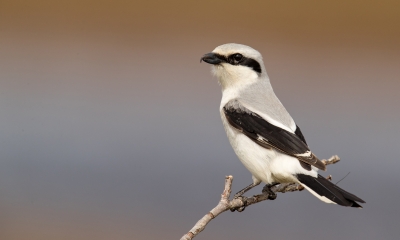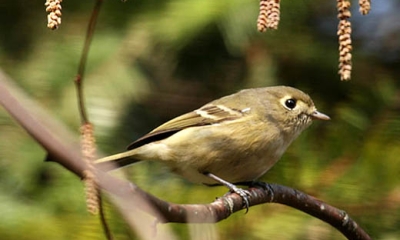
Vireos and Shrikes
Vireos and shrikes are found in open, brushy areas.

Types of Vireos and Shrikes

This striking songbird is best known for its habit of impaling prey on thorns and barbed wire, or wedging items in a v-shaped branch for easier handling and storage.
The Loggerhead shrike breeds in open habitats east of the Cascades where they are rare but regular in the winter, especially at low-elevation sites.
They are uncommon and declining in northeast Oregon. West of the Cascades, there are usually a few records each year during fall, winter, and spring in open habitats of the coast and the Willamette, Umpqua, and Rogue valleys.
The Loggerhead shrike is an Oregon Conservation Strategy Species in the Blue Mountains and Columbia Plateau ecoregions.
Hear the song of the Loggerhead shrike
Photo by Dave Menke, USFWS

This is the larger of Oregon's two shrikes, and the more likely to be seen in winter. Most of those seen in Oregon are hatch-year birds wearing brownish plumage in the fall and graying as winter passes. Adults stand out from young of the year with more crisp gray, black, and white plumage.
Shrikes inhabit open landscapes. They resemble and act like small raptors, however, they capture and kill prey with a hooked bill rather than with talons.
The Northern shrike is an uncommon to locally common visitor in open habitats statewide. It is absent some years along the southern coast.
Hear the song of the Northern shrike
Photo by Mick Thompson, Flickr

The more distinctive features on this gray and greenish vireo are the bright eye rings and lores, together called "spectacles."
This bird is often difficult to see as it forages among the foliage; identification is usually based on hearing its distinctive song. Widespread in migration, when its habitat includes city parks and heavily wooded neighborhoods.
The Cassin's vireo is an uncommon to rarely common summer resident in forests and woodlands, except along the immediate coast. it is an uncommon transient throughout the state.
Hear the song of the Cassin's vireo
Photo by Trish Gussler, Flickr

A quiet, modest, unobtrusive little bird that must be sought to be seen in its shady retreats, this little-studied species can easily be overlooked.
It is typically associated with oaks and mixed woodlands, where it hops along the foliage hunting for insects. In winter it forages with flocks of chickadees, kinglets, and nuthatches.
This is Oregon's only resident vireo. Although it is sometimes referred to as non-migratory, some seasonal movement has been observed. Similar in appearance and behavior to the more common and widespread Ruby-crowned kinglet.
Hear the song of the Hutton's vireo
Photo by Greg Gilson

Despite being one of the most common songbirds in deciduous and riparian forests throughout Oregon, the Warbling vireo is frequently overlooked. Its plumage is indistinct. It tends to forage high in the treetops, moving slowly and deliberately among twigs and leaves gleaning insects.
Despite its subtle plumage and habits, familiarity with its song makes this vireo easy to find, and a delight to listen to.
The Warbling vireo breeds in moderate densities in deciduous habitat throughout Oregon from sea level to montane areas. It is most abundant in the central Coast Range. It is moderately abundant west of the Cascades. During migration, it can be found in almost any deciduous habitat, including areas not typically used for breeding, such as riparian willows not associated with canopy trees.
Hear the song of the Warbling vireo
Photo by Andrew Reding, Flickr

When walking through riparian areas in certain parts of Oregon in summer, one can often hear a song which suggests the Robin's but with less volume and energy, and with a greater variety of phrase. Yet, when one looks up, the bird is often hidden within the canopy foliage.
The Red-eyed vireo is a fairly common summer breeder in Wallowa County and an uncommon to rare breeder in Union County, Baker County, and eastern Grant and Umatilla counties, and northern Malheur County.
Hear the song of the Red-eyed vireo
Photo by John Sutton, Flickr

